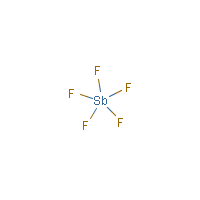Antimony pentafluoride
Agent Name
Antimony pentafluoride
CAS Number
7783-70-2
Formula
F5-Sb
Major Category
Toxic Gases & Vapors

Synonyms
Antimony (V) fluoride; Antimony fluoride; Pentafluoroantimony; [ChemIDplus]
Category
Other Toxic Gases & Vapors
Description
Viscous liquid with a sharp odor; [HSDB]
Sources/Uses
Used as a catalyst and fluorinating agent; [HSDB]
Comments
Hydrofluoric acid formed when F5-Sb reacts with water; Corrosive to eyes, skin, and respiratory tract; Can cause acute pulmonary edema after heavy inhalation exposure; In chronic inhalation studies of animals, pneumonitis as well as liver and cardiac damage are observed. Repeated exposures to fluoride compounds can result in fluorosis. [HSDB] Recent experiments show that "there is essentially very little HF formation; the substance was quite unreactive in water." [CAMEO] See "FLUORIDES." See "Antimony" and linked occupational diseases.
Biomedical References
Exposure Assessment
BEI
Fluorides in urine = 2 mg/L prior to shift or 3 mg/L at end of shift; (Repeated measurements recommended.)
TIH
Yes
TLV (ACGIH)
0.5 mg/m3, as Sb (2.5 mg/m3, as F)
Dangerous When Wet
Yes
PEL (OSHA)
0.5 mg/m3, as Sb (2.5 mg/m3, as F)
MAK
1 mg/m3, as F, inhalable fraction
IDLH (NIOSH)
50 mg/m3, as Sb
Lethal Concentration
LC50 (mice) = 270 mg/m3
Explanatory Notes
Not TIH in land-based spills, but TiH substance released when spilled in water; [ERG 2016] See occupational exposure limits for Fluoride and Antimony compounds.
NFPA
will not burn
Adverse Effects
Toxic Pneumonitis
Yes
Dermatotoxin
Skin burns
Diseases, Processes, and Activities Linked to This Agent
Diseases
Occupational diseases associated with exposure to this agent:
Processes
Industrial Processes with risk of exposure: